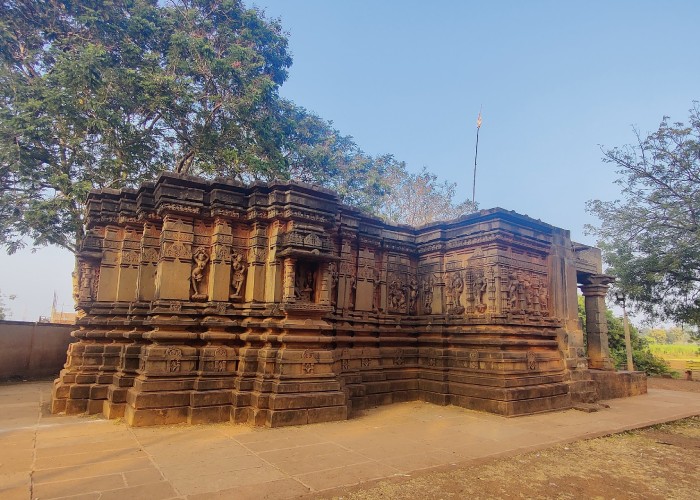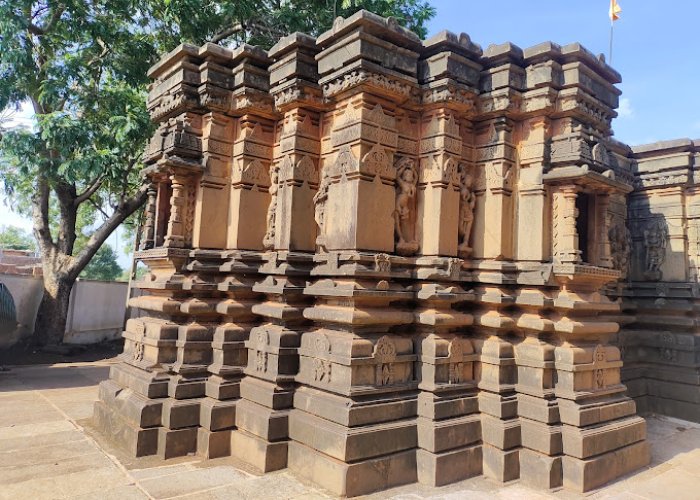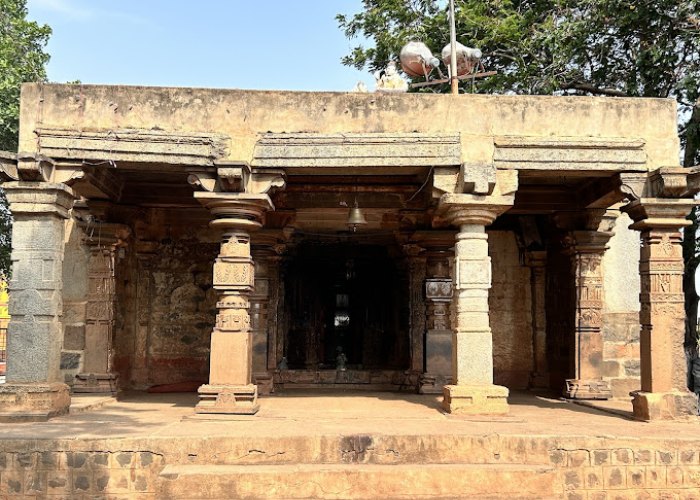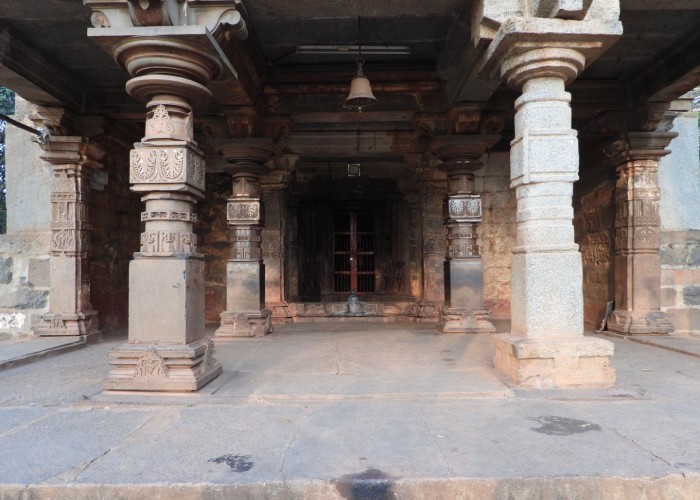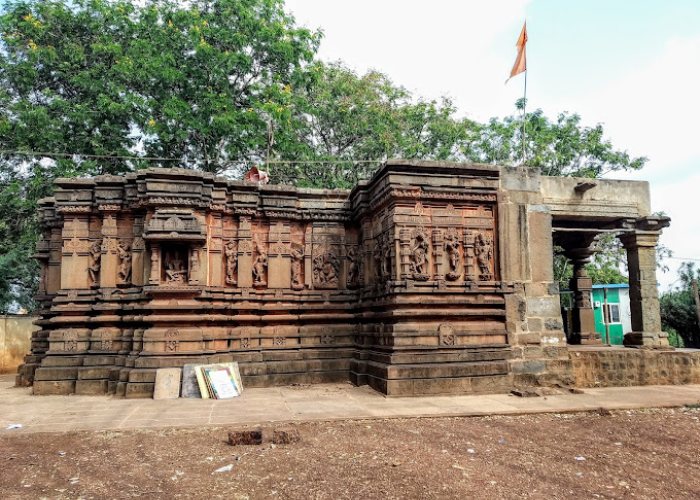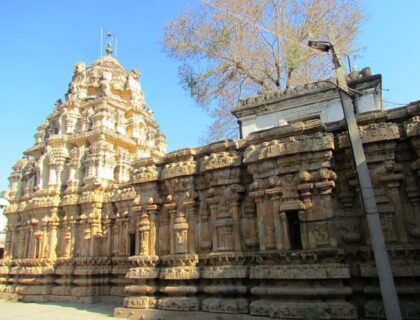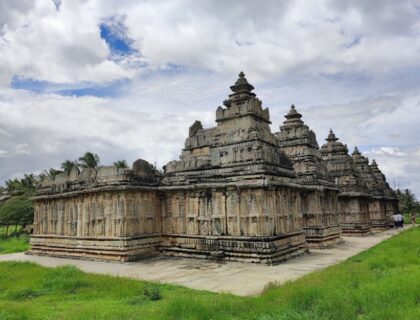Kamleshwar Temple Jalasangvi
Kamleshwar Temple also known as Kalleshwara Temple dedicated to Lord Shiva is located in Jalasangvi village of Bidar district in Karnataka, India. The temple is constructed near the village’s tank about 10 km northwest of Humnabad Taluk of Bidar district. Kamalishwara Temple is well-known for its outstanding Salabhanjika and Madanika sculptures. The temple was built in the Besara style, which is a unique blend of North Indian Nagara and South Indian Chalukya with a Shiv Ling in Garbha Griha.
According to the inscriptions, the temple was built during the reign of the Kalyana Chalukya dynasty’s celebrated emperor Vikramaditya VI. The temple’s interior and exterior surfaces are decorated with beautiful sculptured figures. The figures on the temple’s exterior are of the Salabhanjika or Mandakini style of sculpture. The sculptures of the Jalasangvi temple served as inspiration for later Hoysala Era Temples such as Chennakeshava Temple Belur, Chennakeshava Temple Somanathapura, Kedareshwara Temple Halebidu.
Significance of Kamleshwar Temple Jalasangvi
Jalasangvi or Jalasangi, a small village in Karnataka’s Bidar District, is a significant centre of Kalyan Chalukya art and architecture. The main attraction of this temple is the Madanika Sculpture, which depicts an epigraph praising King Vikramaditya VI of the Chalukya dynasty written in Kannada language.

The Later Chaluklyas, who ruled from Kalyan (now Basavakalyan) from the 10th to the 13th centuries CE, built this Kamleshwar Temple. The temple’s outer walls are decorated with remarkable Apsara sculptures. Their features, postures, and carvings are fascinating in terms of the evolution of sculptural art. Almost all of the region’s temples feature Apsara sculptures.
History of Kamleshwar Temple Jalasangvi
The Jalasangvi Ishwara temple was constructed during the reign of Vikramaditya VI (1076-1226 CE) in 1110 CE. He was an excellent patron of art and culture. Temples were built in abundance during his time. The Kalyan Chalukya period saw a rapid development of temple architecture.

The kings continued their predecessors’ traditions and contributed to the development of rich architecture and sculpture. The Kalyan Chalukya regime built temples in Karnataka’s Gulbarga, Bidar, Raichur, and Yadgiri districts (the entire state of North Karnataka).

The Archaeological Survey of India’s 1996 report “Indian Archaeology 1991-1992 – A Review” describes the temple’s restoration work. “The dilapidated veneering stones of the wall were removed and replaced. Missing slates and roof beams were replaced with new ones. According to the report, the leaking terrace was treated with a “weatherproof course.”

In 2003, the government again carried out restoration work, this time pasting large stone slabs and damaging the sculptures. It was claimed that combining the temple’s originality with modern technology ruined its authenticity.
The Architecture of Kamleshwar Temple Jalasangvi
The Kamleshwar Temple is designed in the Kalyani Chalukya style of architecture. The temple’s interior and exterior surfaces are decorated with beautiful sculptured figures. The figures on the temple’s exterior are of the Salabhanjika or Mandakini style of sculpture.

The temple consists of three chambers. Garbhagriha, a dance chamber with eight pillars, and the Nandi chamber, which has beautiful carvings. There is a Shiv linga in the Garbhagriha. The garbhagriha’s entrance features Dvarapala and Yali designs. The upper portion of the door features a Ganapathi statue.

The temple’s shikhara is missing, possibly because it was destroyed or dilapidated over time. The sculptures on the temple’s outer wall are the main attraction here. The outer wall (bhitti) contains three niches for divinities.

The wall’s indents contain sculptural depictions. A large number of damsels decorate the wall. All of the figures on the outer wall are in dance positions. Their physical stance and sensual treatment make them visually appealing. Their hairstyles, jewellery, and clothing have been given adequate attention. Each Apsara has a distinct posture and is engaged in some activity.

One of the temple’s main attractions is a sculpture of a lady, Shasana Sundari (Shilabalika), an imaginary woman depicted inscribing a Sanskrit epigraph in Kannada characters. The figure in the dancing pose is seen inscribing the epigraph. The Shasanas extol Vikramaditya VI of the Chalukya dynasty.

Important Facts About Kamleshwar Temple Jalasangvi
- Kamleshwar Temple, also known as Kaleshwara Temple, is located in the historical village of Jalasangvi, 45 kilometres away from Bidar and 38 kilometres from Basavakalyan.
- Kamleshwar Temple was built around 1110 AD by the Chalukya dynasty king Vikramaditya VI. During the Chalukyas’ rule in Kalyani, the Jalasangvi village was a thriving hub of activity.
- The temple, built on a star-shaped platform, was designed in the Besara style, which is a unique blend of North Indian Nagara and South Indian Chalukya.
- The temple is small and has a rectangular structure yet very beautiful Temple. Inside the temple, there is a Shiva Linga. The temple’s exterior walls have preserved some outstanding sculptures.
- The temple is famous for its magnificent Salabhanjika or Madanika sculptures. They are lavishly decorated with ornaments and attires.
- The most prominent sculpture here is of a woman writing an epigraph in Kannada.
- The sculptures of the Jalasangvi shrine are said to have inspired the Hoysalas to build bracket figures at Somanathapura, Halebidu, and Belur temples.
- Behind the Kaleshwara temple, a sculpture of Shasana Sundari (Shilabalika), an imaginary woman, can be seen writing Shasana.
- This figure is seen dancing while writing Shasanas praising Vikramaditya of the Chalukya Dynasty.
- The State Archaeology Department maintains control of this ancient temple.
Best Time to Visit Kamleshwar Temple Jalasangvi
This place is very heavenly and spiritual, and you can visit it all year. However, the best time to visit this temple is during the monsoon and winter seasons. During the monsoon season, this location receives moderate to heavy rainfall, making it appear heavenly with its greenery and bringing freshness elsewhere.
Famous Festivals In Kamleshwar Temple Jalasangvi
- Shravana: For happiness and wealth, many fasts, offerings, and mantras are performed during the fifth month of the Hindu calendar, known as Shravana.
- Mahashivaratri is a fasting ritual in the last week of February – March Begining. It is reminiscent of Lord Shiva bringing Goddess Parvati with him. Priests and the temple committee arrange a Grand Celebration.
How to Reach Kamleshwar Temple Jalasangvi
Kamleshwar Temple is a Hindu temple dedicated to Lord Shiva located in the Jalasangvi village of Bidar district in Karnataka, India.
By Air: The nearest airport is Bidar Airport which is 42 km away from the Kamleshwar Temple. There are flights between Delhi and Bidar. You can also fly to Hyderabad and then travel by road to Bidar. From Hyderabad Airport, the Kamleshwar Temple is only 145 Km away.
By Rail: Humnabad is the nearest railway station which is 12 km away from the Kamleshwar Temple. Another option is Hyderabad Railway Station, which is a major railway station approximately 140 kilometres away from the temple.
By Road: Kamleshwar Temple is well-connected to major cities and towns via road. Buses and cabs are available from major cities and towns to Bidar, from which you can take a cab or bus to reach the temple. Jalasangvi is 700 km from Bengaluru and 45 km from district capital Bidar. Buses are available to reach Jalasąngvi from Bidar and Humnabad.
Also Read – Simhanath Temple Gopinathpur
Support Us
If our content helps you even 1% in gaining information about the temple, please support us by contributing any amount, our UPI ID is - q417999792@ybl Or pay using QR CODE >>> Click Now
Location
Facilities
- Drinking Water
- Pooja Item Shops
- Prasad Shops
- Restaurants Nearby
- Resting Room

